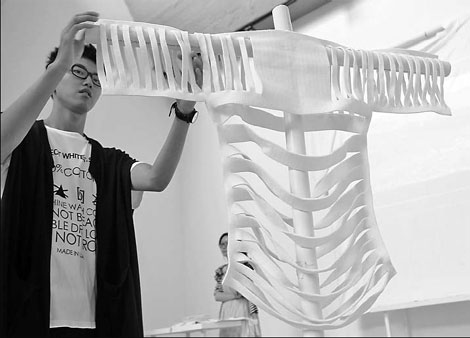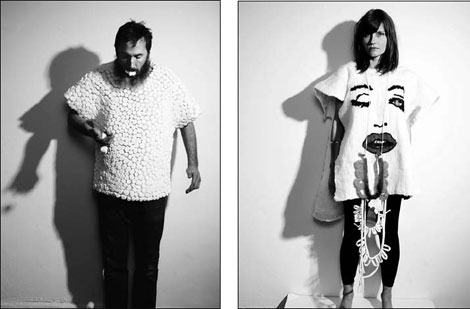Life and Leisure
More than just a T
By Chen Nan (China Daily)
Updated: 2010-09-30 08:02
 |
Large Medium Small |
|
Ritchie Chan's Project White T-shirt brings together 31 designers from 15 countries to re-imagine the wardrobe basic. [Photo by Zou Hong / China Daily] |
|
Left: A model wears a shirt made of white marshmallows, made by Sweden's Doktor Doktor. Right: Australian Narelle Dore's creation is a winter T-shirt that emphasizes comfort and coziness. [Provided to China Daily] |
Avant-garde designers from 15 countries take fashion's most iconic garment, the T-shirt, and give it new meaning. Chen Nan reports
It is said beauty lies in the eyes of the beholder. And for Ritchie Chan, the white T-shirt, fashion's most classic garment, is anything but boring.
In April 2009, 22-year-old Chan started Project White T-shirt to bring together 31 designers from 15 countries, including such notable names as Bruno Pieters, Slow and Steady Wins the Race and Los Angeles-based Unholy Matrimony, to re-imagine the wardrobe basic.
There are shirts made of white marshmallows, made by Sweden's Doktor Doktor, a white T-shirt transformed into a dream catcher by the United Kingdom's Kling by Kling, and even a white shirt buried in designer Brett Westfall's backyard for 185 days, which aims to convey a message of environmental sustainability.
"I like questioning the limits of mass consumer culture. When you walk into a store, what you notice at first is the look of the clothes, their color, shape and images. But I like exploring the ideas and stories behind the clothes, which is not all about buying, selling and branding," says Chan, who was born and raised in Hong Kong.
He pursued his studies in Los Angeles, majoring in business management, international relations, and history. But his first love remains fashion and design, a love that was sparked when he was 16 and worked as a part-time fashion journalist for a Xiamen-based fashion magazine.
In 2009, he opened his own design company, Triple-Major, with the aim of reinventing popular culture.
"The materialistic culture of Hong Kong defines personal worth and identity in terms of branding, which I don't like, but it also inspires curiosity. Not all fashion has to be commercial; it can also be a form of art, of pure expression," he says.
Chan's Project White T-shirt was exhibited in Los Angeles in April. After making its Asia debut in Japan, the exhibition moved in September to Beijing's Ullens Center for Contemporary Art, a non-profit, independent art center located at the 798 Art District, in the northern part of the capital.
Among the Chinese designers participating in the project is Sankuanz, from Xiamen, a coastal city in Fujian province. One of the new-generation designers, he is known for his innovative cuts and creative use of materials while also injecting traditional elements into his designs. For Project White T-shirt, he created a multi-functional garment meant for a homeless person.
"By day, one can wear it as a shirt. By night, by zipping the garment and utilizing the hooks and loops, the shirt can be turned into a small tent," he says.
"The idea just popped into my head after seeing many homeless people wandering the streets of the country. I finished it within one day," he adds.
"This project presented us with a straight-forward challenge, that is, to create an alternative to an iconic item."
Chan has also interviewed the designers and documented the creative process. He says he will post them all on the Project's website, to share the stories behind each shirt with fans.
"Every designer comes from a different background and with varied experiences and this is reflected in the range of ideas which should be valued by buyers," says Chan, who has also opened a concept store inside a narrow hutong near Guloudajie, its location contrasting with the novel designs in the store.
"I like the art atmosphere in Beijing. It is something you cannot find in other cities in China," Chan says. "This environment lets designers give free play to their imagination."
Chan says he will devote his full attention to the store once the Project White T-shirt exhibition finishes touring China.
"My fashion rule is not to bow to commercial pressure," he says. "I hope the store will be more like a gallery displaying designers' works rather than simply selling products."

